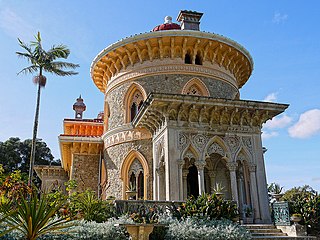
Estoril is a town in the civil parish of Cascais e Estoril of the Portuguese Municipality of Cascais, on the Portuguese Riviera. It is a popular tourist destination, with hotels, beaches, and the Casino Estoril. It has been home to numerous royal families and celebrities, and has hosted a number of high-profile events, such as the Estoril Open and the Lisbon & Estoril Film Festival.

Cascais is a town and municipality in the Lisbon District of Portugal, located on the Portuguese Riviera. The municipality has a total of 214,158 inhabitants in an area of 97.40 km2. Cascais is an important tourist destination. Its marina hosts events such as the America's Cup and the town of Estoril, part of the Cascais municipality, hosts conferences such as the Horasis Global Meeting.

Vila do Porto is the single municipality, the name of the main town and one of the civil parishes on the island of Santa Maria, in the Portuguese archipelago of Azores. Its nearest neighbor, administratively, is the municipality of Povoação on the southern coast of São Miguel, and it is physically southwest of the islets of the Formigas. The population in 2021 was 5,408, in an area of 96.89 km2 (37.41 sq mi).

São Domingos de Rana is a civil parish of the Portuguese municipality of Cascais, part of the Greater Lisbon subregion. The population in 2011 was 57,502, in an area of 20.36 km2. The parish includes the localities Abóboda, Cabeço de Mouro, Caparide, Matarraque, Outeiro de Polima, Polima, Rana, Talaíde, Tires, Trajouce and Zambujal.

Nelas is a municipality located in the Centro Region of continental Portugal. The population in 2011 was 14,037, in an area of 125.71 km².

Lisbon Cascais-Tejo Regional Airport, also known as Tires Aerodrome is a regional airport, situated near the village of Tires, in the civil parish of São Domingos de Rana, in the Portuguese municipality of Cascais, approximately 12 km (7.5 mi) northeast of town of the same name in the Greater Lisbon subregion.
Cristóvão de Figueiredo was a Portuguese Renaissance painter.
Jorge Torlades O'Neill, was the titular and official head of the Clanaboy O'Neill dynasty, whose family has been in Portugal since the 18th century.
Hugo José Jorge O'Neill was the head of the O'Neill Clandeboy dynasty, which ruled a kingdom in Gaelic Ireland until the early 17th century, and has been in Portugal since the 18th century.
António Jorge Martins da Mota Veiga was a Portuguese politician and former Minister and law professor.

The Fort of São Pedro do Estoril, also known as the Fort of Poça, is a medieval fortification, along the coast of the civil parish of Estoril, in the municipality of Cascais. Situated on the beach of Poça, the Fort was part of a group of fortifications during the Joanino era of Portuguese monarchs, built between 1642 and 1648 to form a defensive line between the Fort of São Julião da Barra and Cabo da Roca.

The Curutelo Castle is a well-preserved medieval castle located in the civil parish of Ardegão, Freixo e Mato, in the municipality of Ponte de Lima, Portuguese Viana do Castelo.

The Roman ruins of Casais Velhos are the remains of a Roman town, in the municipality of Cascais, Lisbon District, Portugal that included baths, two cemeteries, remains of a wall and ceramic artifacts.
The Roman villa of Outeiro de Polima is a Roman villa in the civil parish of São Domingos de Rana, in the Portuguese municipality of Cascais, dating from the 1st to 6th centuries AD.

Pedro Manuel Brito da Silva Girão, is a Portuguese engineer, professor, and researcher whose main interest is metrology.

The Portuguese Riviera is a term used in the tourist industry for the affluent coastal region to the west of Lisbon, Portugal, centered on the coastal municipalities of Cascais, Oeiras and Sintra. It is coterminous with the Estoril Coast and occasionally known as the Costa do Sol. Portuguese themselves do not use this expression.

Summer architecture was a Portuguese architectural movement originating in the Portuguese Riviera, in the late 19th and early 20th centuries, when the region became a popular resort destination for the Portuguese royal family and the Portuguese aristocracy. The movement is not characterized by any single architectural style or artistic school, but rather unified by common themes, including leisure, wellness, exoticism, and heterotopia.

Porto is one of the 22 multi-member constituencies of the Assembly of the Republic, the national legislature of Portugal. The constituency was established in 1976 when the Assembly of the Republic was established by the constitution following the restoration of democracy. It is conterminous with the district of Porto. The constituency currently elects 40 of the 230 members of the Assembly of the Republic using the closed party-list proportional representation electoral system. At the 2024 legislative election it had 1,591,760 registered electors.

















